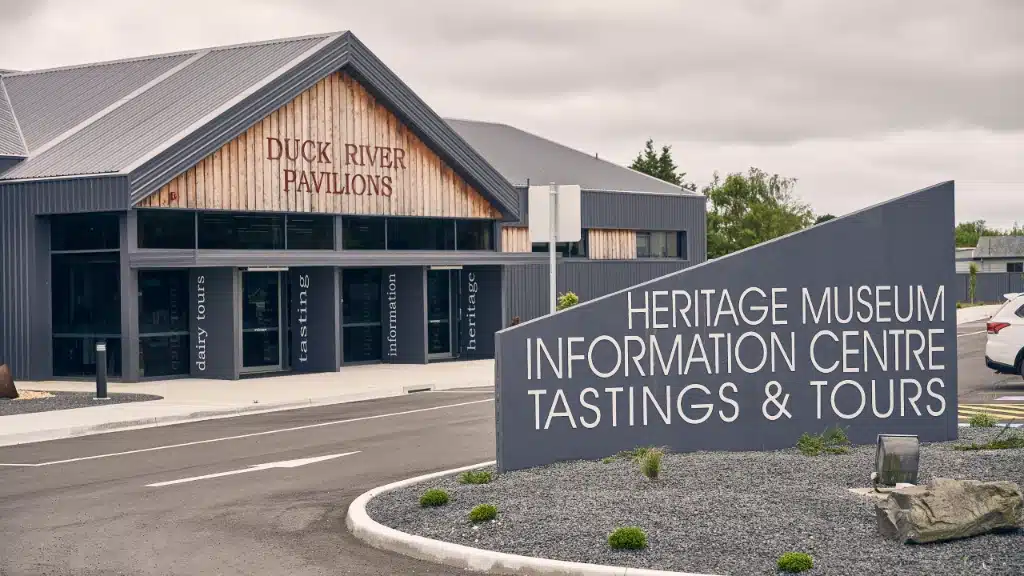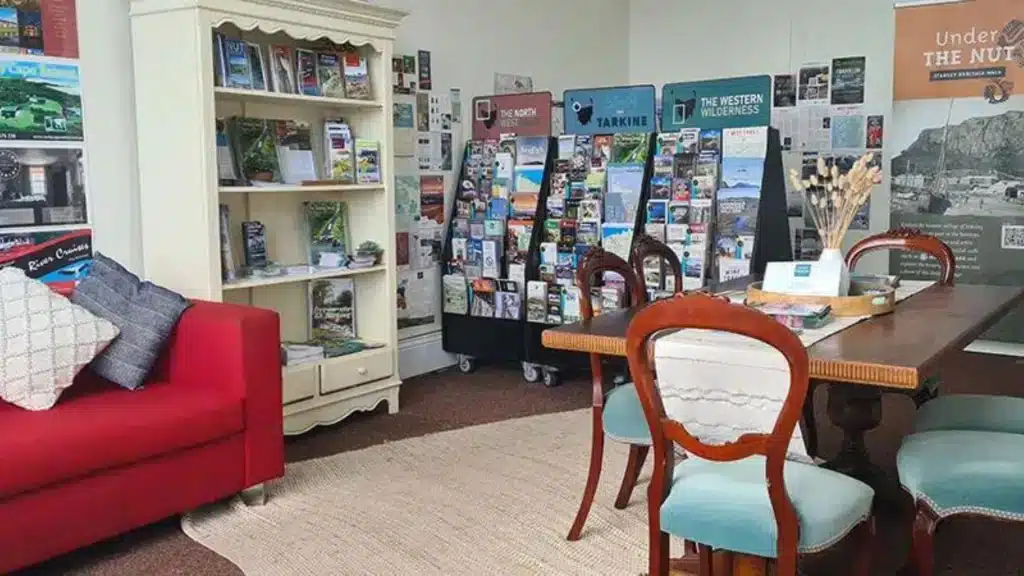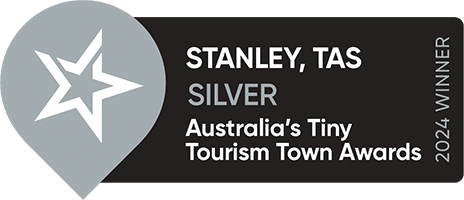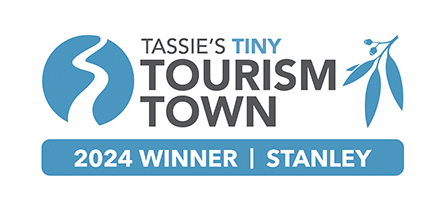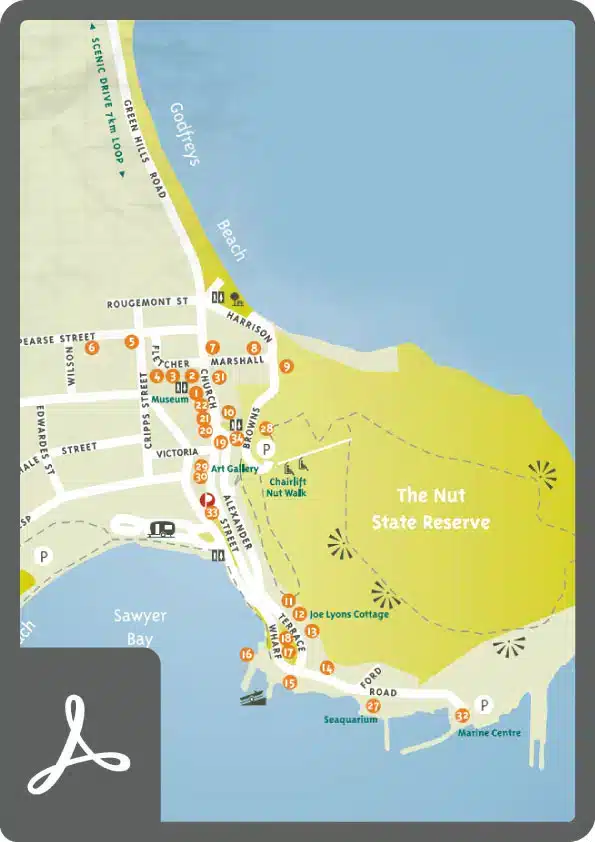Stanley Tasmania
‘Vast stretches of beauty for all to see.’
Lin Eldridge
About Stanley
Remote, windswept and breathtakingly beautiful. Welcome to Stanley.
This isolated village in Tasmania’s far north west is nestled at the base of The Nut – a rugged rocky outcrop that dictates the mood of the township. An early morning wander along your choice of deserted beaches will have you breathing in her majestic presence. The afternoon fall of The Nut’s dark shadow across Stanley signals time to huddle indoors by the fire, whisky in hand.
Stanley’s distance along Tasmania’s far north west coast has largely kept it a closely guarded secret of the locals. But those who make the journey inevitably place the townships romantic tales of yesteryear and breathtaking scenery amongst their Tasmanian highlights. Taking out Tassie’s coveted ‘Top Tourism Town’ accolade in 2021 provides a fitting indication of the town’s boutique appeal and its oft-cited title of the ‘jewel of the north west coast’.
Stanley is cloaked in colonial history. Named after Lord Stanley, British Secretary of State for the Colonies, this picturesque village was settled by the English in the early 1800s. A group of London merchants established The Van Diemen’s Land (VDL) Company, arriving with grand plans that their merino sheep farming would supply cheap wool for British factories. Whilst their intriguing tale unfolded in the hillsides surrounding the township, Stanley’s main street tells the story of everyday life in the 19th century.
Many of Stanley’s original cottages have been beautifully preserved. The Stanley Heritage Walk – a self-guided tour – is the perfect way explore the rich history, architecture and culture of this glorious village. Call into the local Visitor Information Centre to grab a free walk guide and you’ll be off for a one hour stroll that takes in 15 iconic locations. From the Plough Inn that once welcomed weary travellers from Hobart, to Joe Lyons Cottage – the birthplace of Tasmania’s first Prime Minister of Australia. You’ll feel like you’ve stepped back in time.
Stanley’s port was established at the sheltered base of The Nut, providing access for materials and labour bound for the rich agricultural land beyond. Huge sacks of potatoes where amongst the fare shipped back regularly to the mainland in return. The wharf has also diligently served the towns fishing fleet. With shipwrecks abounding, a safe anchorage has remained key for Stanley’s cray boats over the decades. You can still enjoy freshly caught seafood direct from the wharf today.
Whilst compact, Stanley has a perfect sprinkle of amenities. Cafes and bakeries for a coffee and treat, a pub renowned for the local steak and seafood, and a small supermarket if you’re self-catering. An eclectic collection of boutiques awaits those who love to uncover a hidden gem. A stop at the local providore is a must to load up with homemade produce before you stumble into the quirky wine bars for tastings you’ll never forget. The owners love a chat and you’ll easily while away an hour or two.
Accommodation in Stanley varies from comfortable motel lodgings and a family orientated cabin park through to more boutique offerings that draw on the town’s history. Whilst for many it’s hard to beat the long summer evenings that daylight savings graces upon the town, there’s just something special about Stanley in the off season. It’s when the ferocious winds whip across Bass Strait that Stanley is truly at her best. Bunker down and experience the wild and elemental magic.
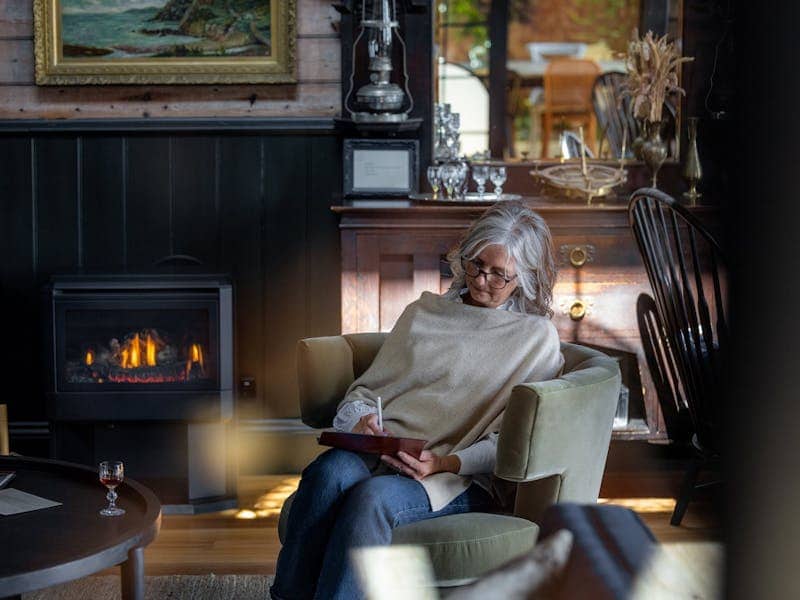
Accommodation
“Where the ocean meets the land, and the past whispers through the streets—Stanley is a place where every stay comes with a view and a story.”
Nestled beneath the towering presence of The Nut, Stanley is a town that holds onto its history while embracing the wild beauty of Tasmania’s northwest coast. Weatherboard cottages, heritage-listed buildings, and waterfront stays line the quiet streets, offering a glimpse into a past shaped by the sea. Wake to the call of seabirds and the scent of salt in the air, where the rhythm of the tides sets the pace for slow mornings and long, golden afternoons.
Accommodation here is as charming as the town itself. Stay in a historic guesthouse, where fireplaces crackle and verandahs overlook the bay. Choose a boutique retreat, where luxury meets coastal seclusion. Or settle into a cosy seaside cottage, just steps from the shore, where the waves lull you to sleep.
At day’s end, as the sun dips behind the endless horizon, Stanley invites you to slow down, settle in, and stay a little longer. Because here, between the sea and the sky, time seems to stand still.
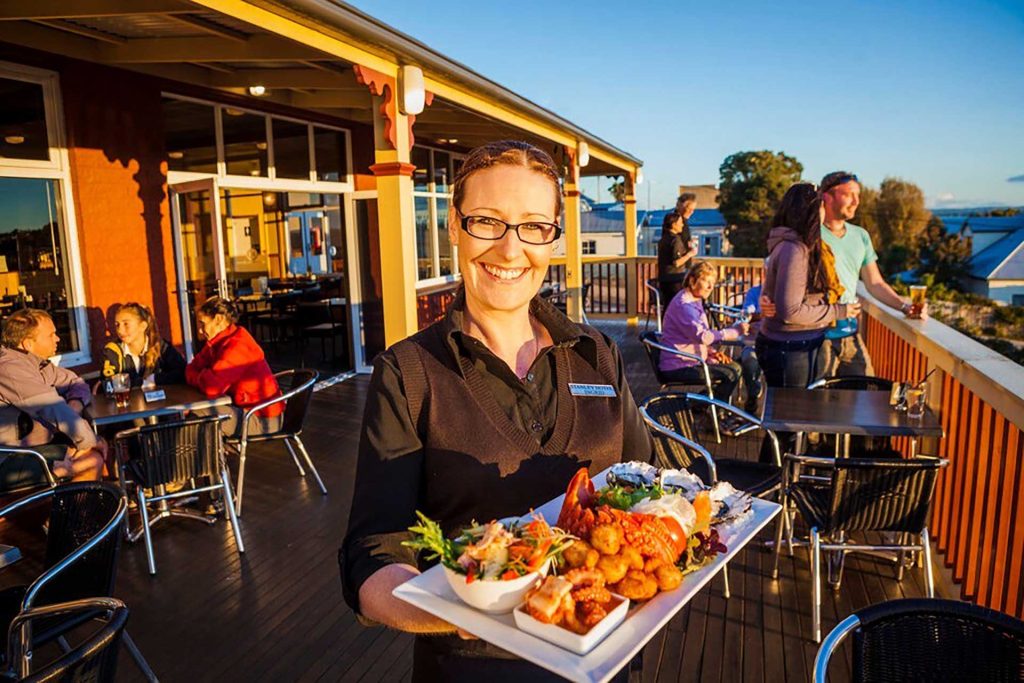
Food & Drink
“Where the sea meets the plate and the land pours a glass, Stanley serves up flavors as rich as its history.”
Food in Stanley is more than just a meal—it’s an experience, shaped by the wild waters of Bass Strait and the fertile farmland beyond. Hursey Seafoods is legendary here, serving up the freshest crayfish, scallops, and line-caught fish straight from the family’s own fishing boats. A meal here isn’t just about taste—it’s about tradition, a celebration of Stanley’s deep connection to the sea.
For those who prefer a long, leisurely evening, Stanley Wine Bar offers a curated selection of Tasmanian wines, craft beers, and local produce platters, best enjoyed by a crackling fire or under the soft glow of fairy lights. At Marley’s, modern flavors meet coastal charm, with seasonal dishes, great coffee, and a laid-back atmosphere. Meanwhile, Touchwood combines history and hospitality, offering homemade treats and artisan coffee in a heritage setting, where every bite comes with a stunning ocean view.
For a classic pub meal, Stanley Hotel is the heart of the town. Here, hearty plates of local steak, seafood, and comfort food are served with warm country hospitality, making it a favorite among locals and visitors alike. Whether you’re indulging in a decadent seafood feast, sipping a glass of fine Tasmanian wine, or simply enjoying a homemade scone with a view, eating in Stanley isn’t just about filling up—it’s about slowing down, savoring the moment, and tasting the essence of Tasmania’s northwest coast.
Shopping
“Tucked between the sea and The Nut, Stanley is a place where shopping is as much about discovery as it is about what you take home.”
Wandering Stanley’s streets feels like stepping into another time—heritage buildings, charming storefronts, and the salty scent of the ocean in the air. Here, shopping isn’t about rushing; it’s about exploring. At Crossland Antiques, history lovers will find a trove of vintage collectibles, fine china, and Tasmanian curiosities, each piece with a story to tell. For those after something truly special, The Angel’s Share is a treasure chest of handcrafted Tasmanian whisky and wine barrels transformed into stunning gifts, furniture, and keepsakes.
For a taste of local flavors, Providore 24 offers gourmet cheeses, jams, Tasmanian wines, and handmade treats, perfect for a picnic by the sea. The Nut Café and Store is another must-visit, serving up artisan goods, delicious local produce, and freshly brewed coffee to fuel a day of exploring. And for those in search of classic Australian style, Stanley Post Office doubles as an R.M. Williams store, stocking quality leather boots and country wear.
No visit is complete without a stop at the Stanley Hotel Gift Shop, where locally made crafts, souvenirs, and Stanley-inspired keepsakes make it easy to take a little piece of this charming town home with you. Whether you’re hunting for antiques, savoring gourmet delights, or picking out a timeless piece of Tasmanian craftsmanship, shopping in Stanley is about more than just what you buy—it’s about the stories, the people, and the magic of this coastal gem.
Heritage & History
“The wind carries whispers of the past, the streets hold the footsteps of pioneers, and the land remembers all who have called it home.”
Stanley is a town where history lingers. Long before European settlers arrived, this rugged coastline was home to the palawa people, who lived in harmony with the land and sea, leaving behind ancient middens and pathways that still whisper their stories. The arrival of explorers in the early 1800s changed everything. By 1826, the Van Diemen’s Land Company (VDL) had established Stanley as its main settlement, drawn to the rich farmland and the strategic harbor beneath The Nut, the town’s iconic volcanic rock formation.
The past is everywhere here. Walk the quiet streets lined with historic weatherboard cottages, and you’ll find Highfield House, the grand colonial homestead that once housed the VDL Company’s chief agent. Overlooking the sea, this heritage-listed estate tells the tale of early European settlement, complete with convict-built outbuildings, sweeping gardens, and rooms frozen in time. Down by the waterfront, Stanley’s old port and wharf stand as reminders of the town’s long connection to the sea—once a bustling hub for fishing boats, whaling ships, and trade vessels.
Today, Stanley holds onto its past while embracing the present. Many of its heritage buildings have been lovingly restored, now home to boutique accommodations, cafés, and galleries that celebrate its unique history. Whether exploring Highfield House, wandering the historic streets, or gazing out to sea from atop The Nut, Stanley is a place where the past is never far away, and every step is a walk through time.
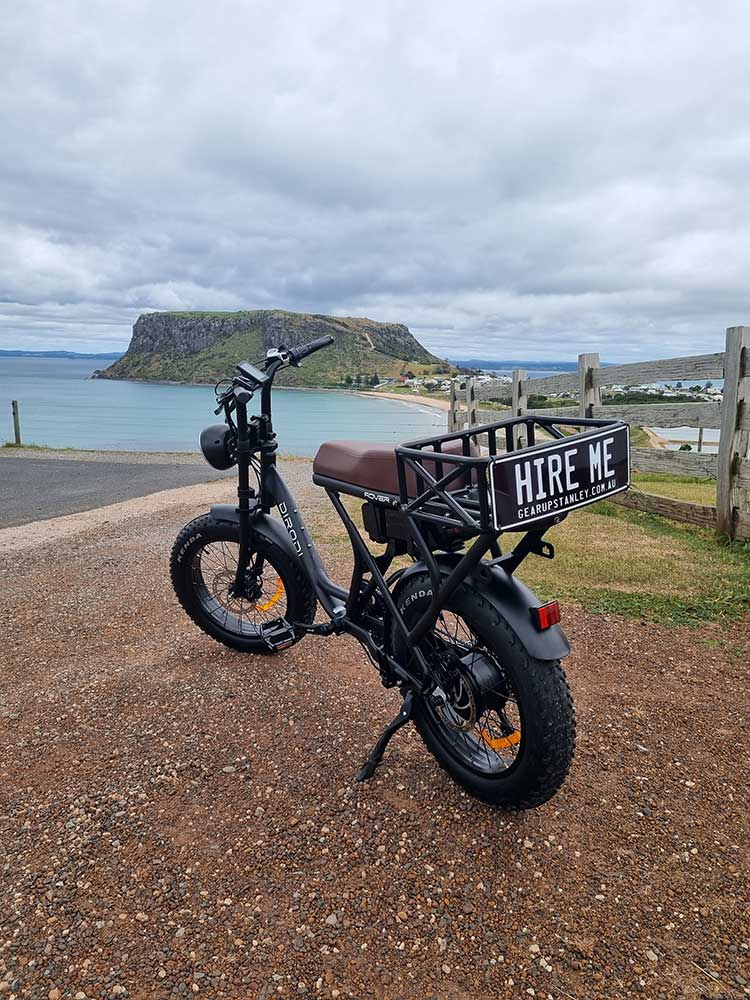
Activities
“Where the wind sweeps across the cliffs, the ocean carves the shore, and every path leads to adventure.”
Stanley is a town built for exploring. At its heart stands The Nut, a towering volcanic rock formation that dominates the landscape. Take the steep walking track to the summit or ride the Stanley Nut Chairlift, where breathtaking 360-degree views of Bass Strait and rolling farmland reward those who reach the top. The Nut’s loop track offers stunning coastal vistas, nesting seabirds, and the occasional wallaby, making it one of Tasmania’s most iconic short walks.
For history lovers, a visit to Highfield Historic Site reveals the story of Stanley’s early European settlement. Wander through convict-built stone buildings, stand in the grand homestead’s elegant rooms, and imagine life in the early 19th century. Down by the waterfront, the town’s historic wharf and fishing docks invite you to watch local boats return with the day’s catch—perhaps even stopping at Hursey Seafoods to taste freshly caught crayfish straight from Bass Strait.
Nature is never far away in Stanley. Take a scenic beach walk at Godfrey’s Beach, where little penguins waddle ashore at dusk, or venture to Dip Falls and the Big Tree, a hidden gem of cascading waterfalls and ancient rainforest just a short drive from town. Out on the water, fishing, boating, and wildlife cruises offer the chance to spot dolphins, seals, and seabirds that call these wild waters home.
Whether hiking, history-hunting, or simply soaking in the coastal charm, Stanley is a place where adventure comes naturally, and every moment feels like a step into Tasmania’s untamed beauty.
Events
Travel Info & Maps
“Follow the coast, where the road hugs the sea and the horizon stretches wide—Stanley is waiting at the end of the journey.”
Perched on the edge of Tasmania’s northwest, Stanley is just 90 minutes from Burnie and a scenic 2.5-hour drive from Devonport, where the Spirit of Tasmania ferry docks. The journey along the Bass Highway (A2) is an adventure in itself, winding past rolling farmland, windswept coastlines, and quaint country towns before reaching the shadow of The Nut, Stanley’s iconic volcanic landmark.
For those flying in, Burnie Airport (Wynyard) is the closest option, with flights from Melbourne. From there, it’s an easy drive through the rich dairy country that has shaped the region’s history. Public transport options are limited, so hiring a car is the best way to explore Stanley and its surrounding wonders, including The Tarkine, Arthur River, and the rugged west coast.
Once in town, Stanley is best explored on foot, with heritage streets, historic sites, and stunning coastal walks all within easy reach. Whether you’re staying for a day or settling in for a longer retreat, Stanley is a place that rewards the slow traveler—one where every road leads to a story, every path to an adventure, and every sunset to another reason to stay.


